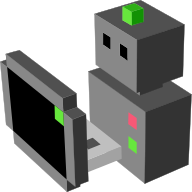HLA-based hybrid simulation hla¶
In this tutorial, we show how to use HLA to setup a hybrid simulation. A hybrid simulation in the MORSE context is made up of at least one MORSE node, connected in an HLA federation to other nodes, which may be other simulators (e.g., think about a simulation model for a quadrotor available as a standalone library/binary), or even real robots.
Prerequisites¶
You need to install the HLA libraries for MORSE, by following the HLA documentation. We also recommend you to have a look at the HLA multi-node tutorial.
To setup the HLA federation, you also need the RTI gateway to be running. Open a new shell terminal and start it:
$ rtig
The MORSE scenario¶
You can find the scenario file
in $MORSE_ROOT/share/morse/examples/tutorials/multinode/tutorial-hla-hybrid.py.
This file is very close to the multi-node scenario. It has one robot located in the “grande-salle” scene:
from morse.builder import *
atrv = ATRV()
env = Environment('laas/grande_salle')
env.show_framerate(True)
env.show_physics(False)
We configure HLA and indicate that the ATRV robot is managed by node “atrv”, and we create the environment:
env.configure_multinode(protocol="hla", server_address="127.0.0.1", server_port=60400,
distribution={"atrv": [atrv.name],})
env.set_camera_rotation([1.3300, 0, 0.7854])
env.set_camera_location([10.0, -10.0, 3.0])
env.create()
Note
The node name in distribution is only relevant to indicate to MORSE if it has to export the robot’s position or not. This name will not be used by non-MORSE federates.
To launch the MORSE node, just run MORSE with the tutorial scenarion:
$ morse run ${MORSE_ROOT}/share/morse/examples/tutorials/multinode/tutorial-hla-hybrid.py
Publishing the ATRV position using Python¶
You can find the example file in $MORSE_ROOT/share/morse/clients/hla/hybrid-client.py.
This sample code is designed to be integrated in a non-MORSE federate (another simulator or a real robot architecture), in order to publish the robot position so that it is correctly reflected into MORSE. Let’s look at some relevant parts of the code.
import hla
import hla.rti as rti
import hla.omt as fom
These lines import the HLA python modules. They are provided by the pyHLA library.
MorseVector = fom.HLAfixedArray("MorseVector", fom.HLAfloat32LE, 3)
This line defines the vector type used for MORSE robots’ position and orientation.
class MorseHLAClient():
def __init__(self, robot_name, host="localhost", port=60400):
self.fom = "morse.fed"
self.federation = "MORSE"
self.robot = None
if os.getenv("CERTI_HTTP_PROXY") == None:
os.environ["CERTI_HTTP_PROXY"] = ""
os.environ["CERTI_HOST"] = str(host)
os.environ["CERTI_TCP_PORT"] = str(port)
The MorseHLAClient is the example’s main class. The first lines of its constructor define some useful variables. The fom and federation name must not be changed: they are defined in MORSE’s HLA plugin. The CERTI environment variables are used to locate where the RTIG has been launched on the network.
self.rtia = rti.RTIAmbassador()
self.rtia.createFederationExecution(self.federation, self.fom)
self.morse_ambassador = rti.FederateAmbassador()
self.rtia.joinFederationExecution("hla-client", self.federation, self.morse_ambassador)
The constructor continues by creating the RTI Ambassador and a Federate Ambassador. It creates the federation and joins it.
self.robot_t = self.rtia.getObjectClassHandle("Robot")
self.position_t = self.rtia.getAttributeHandle("position", self.robot_t)
self.orientation_t = self.rtia.getAttributeHandle("orientation", self.robot_t)
self.rtia.publishObjectClass(self.robot_t, [self.position_t, self.orientation_t])
self.robot = self.rtia.registerObjectInstance(self.robot_t, robot_name)
Then, it gets from the RTIG some handlers for the data types that will be manipulated, declares that is will publish a robot object with attributes position and orientation, and finally register the “ATRV” robot.
def send(self, x, y):
hla_att = {self.position_t: MorseVector.pack([x, y, 0]),
self.orientation_t: MorseVector.pack([0, 0, 0])}
self.rtia.updateAttributeValues(self.robot, hla_att, "update")
self.rtia.tick()
The send method is used to send the robot’s position to the HLA federation.
You can start this client with:
$ python3 $MORSE_ROOT/share/morse/clients/hla/hybrid-client.py
The ATRV position will randomly change in MORSE according to the data sent by the client. Congratulations, you have performed some hybrid simulation!
Subscribing to the ATRV position using Python¶
When performing hybrid simulation, you may be interested in getting the ATRV position from MORSE to integrate in your specific simulation federate (think about a communication simulator that needs the robot position to simulate the communication quality without using the Blender physics).
Subscribing to an object in HLA is based on callbacks, called when receiving messages (existence of new object, new data published, etc.) The Python code is hence a bit less straightforward than for publishing.
If you are interested in doing this, look at the MORSE HLA plugin, since this
implements publishing/subscribing behaviours. You can find it in
$MORSE_ROOT/lib/python3.2/site-packages/morse/multinode/hla.py.
